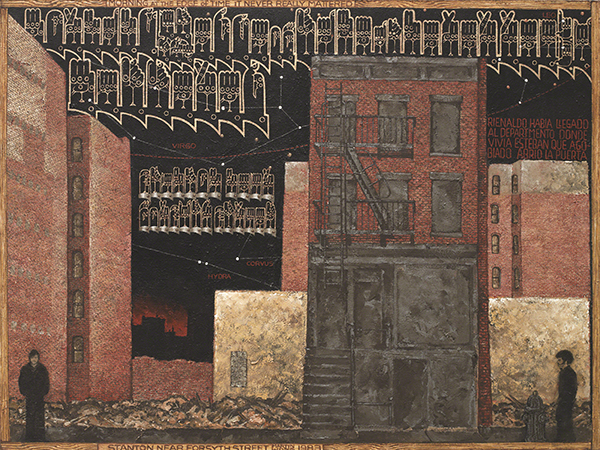Pride Month 2021 I: Martin Wong
We end Asian American and Pacific Islander Heritage Month and begin LGBTQI+ Pride Month with a wonderful, gentle soul. Martin Wong was part of the vibrant art community in the East Village of New York during the 1980s. He once commented that all of his subject matter was found within four blocks of his apartment. The Martin Wong Residence and Studio at 141 Ridge Street is an NYC LGBTQ Historic Site.
 |
| Martin Wong (1946–1999, U.S.), Stanton Near Forsyth Street, 1983. Synthetic polymer paint on canvas, 48" x 64" (121.9 x 162 .6 cm). Courtesy of the Museum of Modern Art, New York. © 2021 The Estate of Martin Wong, PPOW Gallery, New York. (MOMA-P5119) |
Many of Wong’s meticulously painted images of the Lower East Side include fragments of poetry by his boyfriend, Miguel Piñero (1946–1988), a leading poet of the Nuyorican Literary and Art Movement. Nuyorican was a group of artists of Puerto Rican descent who were born in New York and sought to document and celebrate their unique culture.
In Stanton Near Forsyth Street, Wong depicted himself on the lower left and Piñero on the lower right. Passages from Piñero’s written work are included in the frame and as graffiti-inspired stylized hand-gestures based on American Sign Language. The poem refers to the night sky, further emphasized by labeled constellations. Paintings like this reflect Wong’s habit of taking long walks in his neighborhood. They are documents of a New York that no longer exists. Wong's mature style also included lyrical depictions of Chinatown in New York and San Francisco.
Wong was born in Portland, Oregon, to parents of Chinese descent, and raised in the Chinatown district of San Francisco. He studied ceramics at Humboldt State University from 1964 to 1968. Throughout college and for another 10 years he was active in the San Francisco Bay Area art scene, including designing sets for gay performance art groups. In order to make money, Wong produced photorealistic portraits of people at street fairs for $7.50 each. Because of the acuity of his work, friends convinced him to market his art in New York in 1978.
Once Wong moved to New York, he became immersed in the Puerto Rican and Asian communities of the Lower East Side of Manhattan. He became involved in the graffiti movement, accumulating perhaps the largest collection of art by graffiti artists in the U.S., which he donated to the Museum of the City of New York in 1994 (the year he moved back to San Francisco). His mature work documented the vibrant artistic community of the Lower East Side, as well as the dilapidation of the buildings and the sense of isolation and displacement faced by the inhabitants as that section of New York began to be recognized for its gentrification potential.
The East Village was way ahead of Soho during the 1980s as a germinal artistic community. It had experimental galleries, artist collectives, and hip-hop clubs enlivening the atmosphere and giving alternative space to artists who eschewed the “chic” of Soho or the elitism of Greenwich Village, both of which had prided themselves on being artistic “colonies” during the early part of the 1900s. Wong’s paintings are a combination of unsparing realism and the naivete of visionary artists, which sort of summed up the atmosphere in the period from around 1983 to 1987.
Once nearly overlooked by the art establishment, Wong was acknowledged in his New York Times obituary as an artist "whose meticulous visionary realism is among the lasting legacies of New York's East Village art scene of the 1980s."


Comments